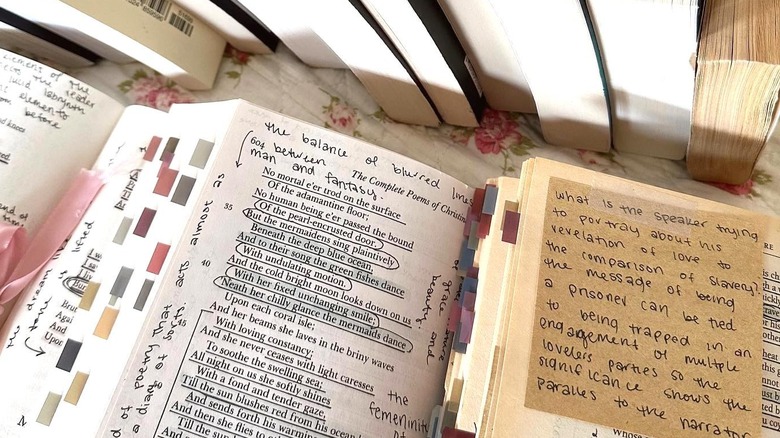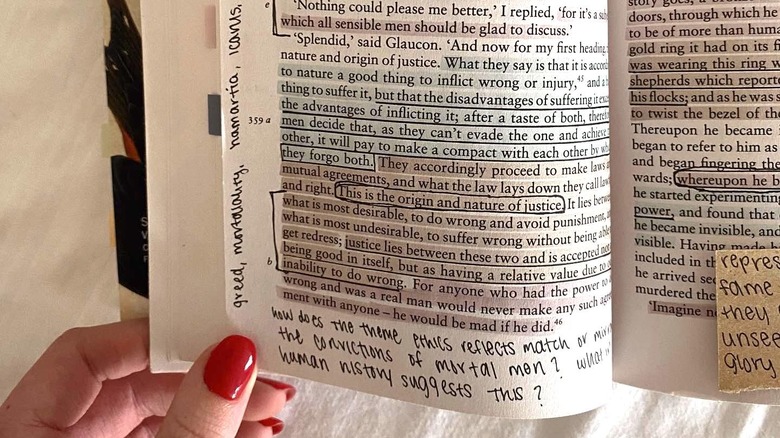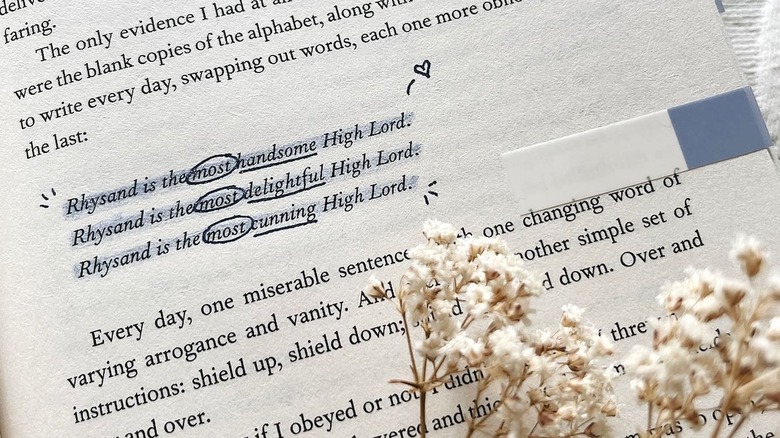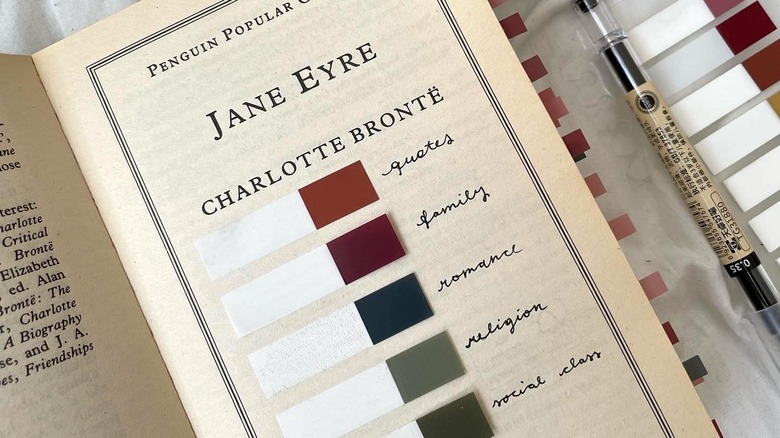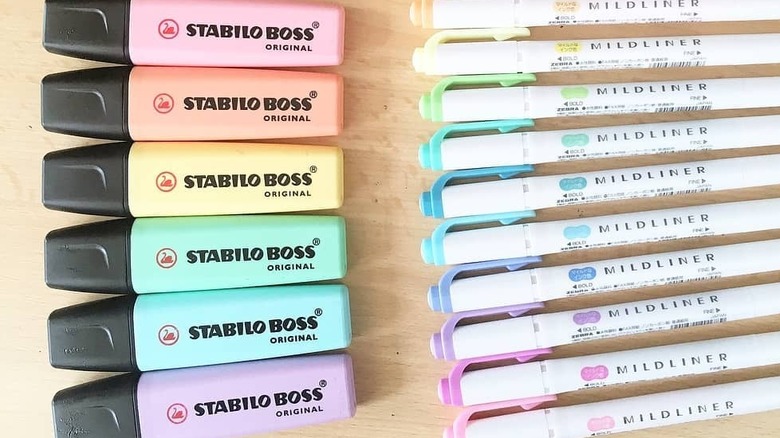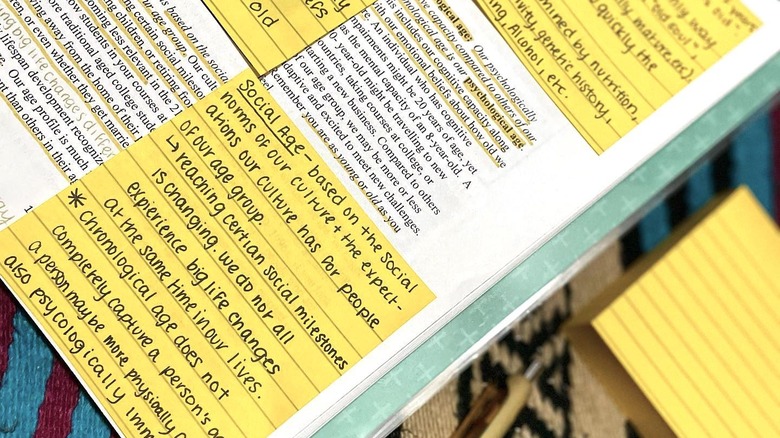Take Your Reading Habit To The Next Level & Start Annotating Your Books
For a minute there, it looked like books — and especially physical copies — might be going the way of the dinosaurs. But reading has taken on a whole new glamor thanks to the wild popularity of online communities like #booktok and #bookstagram. With so much inspiring book content now making the rounds, many people are flocking back to reading or looking for tricks to engage with this hobby in whole new ways.
Enter book annotation, the perfect activity to take your reading habit to the next level. Annotation is all about analyzing and responding to the books you consume, turning your passive reading experience into a truly interactive hobby.
Maybe you're already a regular bookworm who wants to get even more out of your reading time and bring your own insight and creativity to the table. Annotation provides the outlet you're looking for. Or perhaps you're an aspiring reader looking for habits that will help you read more. After all, many of us struggle to just relax and enjoy a book. Even if we do have the time, a tendency toward toxic productivity may mean that our attention span keeps wandering back to our to-do list and other responsibilities.
Wherever you are in your current reading journey, annotation can help you feel a sense of progress and focus when you pick up a book. This, in turn, can encourage you to dedicate more time to your reading hobby. Sound too good to be true? Try it for yourself! Here's everything you need to know about annotating books, and how to get started.
What is book annotation, exactly?
Book annotation is a way of recording your own thoughts and reactions to the text you're reading, whether you're marking ideas to return to later or simply emphasizing a turn of phrase you particularly loved. Often, these notes are written directly into the book itself or added with bookmarks and sticky notes.
Annotation is a helpful tool for close reading and analysis, as it turns reading into an active experience. Instead of just riding the wave of the narrative, your brain starts looking for opportunities to make observations, keeping your attention more focused. This can help improve your memory and comprehension of the text. But while annotation has traditionally been a learning technique used for studying and academia, it can also be used to connect more fully with a book you're reading for entertainment.
You can use various techniques to mark up your text, depending on your style and goals. Some common approaches include highlighting or underlining significant passages, writing brief notes in the margins, and bookmarking pages to revisit. But these are just the tip of the iceberg. Many book enthusiasts prefer finding their own ways to annotate, such as adding doodles, iconography, or even full summaries at the end of a chapter. The world — or in this case, the book — is your oyster.
Reasons to annotate your books
Wondering whether annotation is really worth your time? Let's put it this way: Annotation is a fantastic method to get more out of any book. For instance, say you're trying to learn something. You can annotate books you're reading for school, work, or your own self-improvement to better remember and internalize information. Whether it's a volume on American history or discussing reliable ways to build new habits, annotation enables you to highlight the information that seems most important and lock it into your memory banks.
Book annotation also helps you interact with your just-for-fun reads on a deeper level. Have you ever read a sentence that made your heart and mind scream internally? Grab a highlighter and preserve that moment for posterity. This kind of reading is like the literary equivalent of mindful eating, letting you savor the book from beginning to end. Plus, next time you read this copy of the book, your notes will make it feel like you're re-experiencing the whole journey hand-in-hand with your past self.
Annotation can even help you become a more analytical reader to improve your own writing. Annotate books you love to identify what makes them work, from character development and plot progression to the beauty of descriptive language. Picking apart the mechanics hidden in your favorite books will make you a more thoughtful writer and suggest new elements to examine in your own work.
Annotation is perfect for any type of text
If you're only accustomed to taking notes on books you read for school, annotation may not seem quite natural at first. But this technique can be adapted to almost any kind of book. For instance, annotating a nonfiction book like a memoir or how-to guide is only a short jump from studying your textbooks of yore.
Annotation is also a great way to enhance your connection with fiction, encouraging you to look deeper into the story and characters. This can enrich your experience with any novel. You can even annotate texts like stage plays or books of poetry. Use close reading to really delve into the themes and language, annotating the phrases or imagery that resonate with you the most.
You don't even have to like a book to enjoy annotating it. Just as you might enjoy mocking a bad movie with friends, use annotation to roast a truly awful read. It can be cathartic and satisfying to scrawl your critiques into the margins, whether you're frustrated with unlikable characters or problems in the writing itself.
On the flip side, it can be a lot of fun annotating a book you love and want to share with a friend. Leaving behind notes, exclamations, and highlighted passages will create instant points of conversation as the book's next reader follows in your footsteps. This is especially entertaining if you have a regular reading buddy, as you can both annotate and swap books back and forth almost like trading notes in class.
Can you annotate books without writing in them?
If you're the type of reader who won't even fold down page corners, then the idea of writing in a book may give you the heebie-jeebies. Fortunately, there are plenty of ways to annotate and personalize your copy of a favorite text without doing any permanent damage. One of the easiest and most popular ways to annotate a book without writing in it is the liberal use of sticky notes and tabs. Just scribble down your notes or questions and stick them to the page like an annotation bookmark.
If you have a lot to say, you can also pick up a separate notebook or bullet journal to serve as a one-stop shop for all your annotations. Record your thoughts, copy entire quotations, and take notes on informative content. For an even quicker, more helpful reference, jot down the page or chapter numbers you're referring to. Just keep in mind that page numbering may vary between editions of a particular text. Keeping a separate annotation notebook is especially handy if you prefer to read a lot of library books rather than purchasing your own copies. You may have to return a library book, but you can keep your annotation notebook in perpetuity.
But what if you're an aficionado of e-books? Good news, tech-savvy reader: You can also annotate digital copies of all your favorite tomes. Whether you're a fan of Amazon's Kindle, the Barnes & Noble Nook, or a third-party e-reader, chances are good that your app has annotation capabilities. These may include adding notes, bookmarks, and even highlighting passages. While annotating an e-book may not be as intimate and visceral as decorating a physical text, it still provides you with an outlet to track your thoughts and reactions.
How to start annotating books
Once you decide to start experimenting with book annotation, a lot of it will be intuitive and specific to you. But before you get started, it can help to set yourself a few goals and ground rules to guide the arc of your annotation strategy. First, determine what kind of notes you want to make. Are you annotating purely for the joy of it? Then maybe your scribbled marginalia will be full of exclamations like "I love this!" and excited circles around your favorite phrases or moments.
If you're trying to emulate a book in your own writing, pick out a few specific facets you want to analyze and mark them as you go — whether you're more interested in big ideas like theme and structure or small flourishes like imagery and word choice. And if you're studying an educational book, you may want to start your annotation with an eye for unfamiliar terminology, key concepts, or useful explanations.
It can also help to create your own annotation color key before you begin, especially if you'll be making several different types of notes or remarks. For instance, use your favorite colored pen or highlighter to illuminate a phrase you loved, an aggressively neon color for things you want to remember, or a color you dislike for mistakes you'd want to avoid in your own writing.
You can also use colors to differentiate notes by purpose, such as using one hue to denote new vocabulary and another to highlight moments where the author cleverly derailed your expectations. Get creative and build this color code around your own annotation goals to make it work for you!
Book annotation supplies for beginners
How you choose to annotate your book collection will obviously depend on your goals and style. But certain tools and supplies may be useful to keep on hand. After all, you don't want to miss a flash of inspiration just because you can't find a pen. And the more eye-catching you make your annotations, the more memorable and inspiring they'll become. To that end, your book annotation kit should probably include most or all of the following supplies.
First and foremost, treat yourself to some nice pens in various colors. Make sure they're pleasant to write with, but won't bleed through the page. Felt-tipped pens may be too heavy, so consider colorful ballpoints or classic gel pens. A ruler is also handy to help keep any arrows and underlining neat. A 12-inch ruler can be a bit unwieldy, though, so keep an eye out for shorter options, like a miniature six-inch ruler. You may also want to grab a pack of assorted highlighters, which are great for easily color-coding noteworthy phrases or paragraphs.
To take your book annotations further, consider including sticky notes, note cards, and annotation tabs among your supplies. These are all useful tools for including longer thoughts without cramming a page or making annotations without physically marking up the text. Plus, book annotation tabs make it fast and convenient to find sections where you left a lot of notes. Or, if you're trying to keep your notes entirely separate, don't forget a notebook for all your observations.
Annotating informative texts
When you're reading any kind of educational or informative book, annotation helps engage your brain by making studying more interactive. Plus, leaving yourself notes and bookmarks essentially creates a study guide as you go, so you know which chapters, pages, and passages to revisit when you want to review what you've learned.
To get the most out of an informative text, here are a few key ways to use annotation to your advantage. First, be sure to highlight any must-remember points. You can also mark passages you need clarification on, so you know where to dive deep or ask for outside help. By the same token, consider underlining moments where an explanation clicked for you, so you can cement the whole concept in your brain.
Sometimes, you may run across new ideas that aren't explained in the book itself. Mark any references you want to research more later, like unfamiliar scientific principles, mythological figures, or historical events. You can even broaden your vocabulary this way by tagging new words you didn't know before. In no time at all, your book will become more than the sum of its parts as you turn it into an index for your own education and growth.
Annotating books just for fun
When it comes to annotating a book just for funsies, the options are nearly limitless. Highlight a favorite quote or a sensory detail that made your breath catch. Note down examples of successfully paced dialogue. Point out moments when someone seemed to behave out of character, and why you think so. Underline recurring imagery and motifs, then see if you can identify their significance as you read.
You can also record bigger ideas in your annotations, like plot predictions. Think you know who committed the murder or how the author is going to reveal a big twist? Make a note. Later, you can look back and see if you got it right. Sometimes, a book may even give you an idea for your own project. Go ahead and write it down in your annotations so you can keep reading without losing that spark of inspiration. And if you're the artistic type, there's no rule saying you can't draw in the pages of a book. Turn your favorite tome into a one-of-a-kind illuminated manuscript by doodling in the corners and margins.
In the end, book annotation is what you make of it. There are no hard and fast rules, just the gut feeling that something matters. Anytime a word, phrase, or plot development makes you pause, think about why it caught your attention. It's probably worth annotating!

